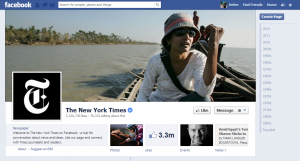nytimes.com goes offline and directs 9m Twitter followers to Facebook
By Helen Rankin on Thursday, August 15, 2013
24 hours after the New York Times went offline ‘for technical difficulties’ and it’s still unclear as to whether this was a bold PR stunt or just good PR.

24 hours after the New York Times went offline ‘for technical difficulties’ and it’s still unclear as to whether this was a bold PR stunt or just good PR.
On 14 August at approximately 11.00am EST, the official website of the New York Times (nytimes.com) and its mobile apps went offline. 9m Twitter followers were directed to the newspaper’s Facebook page where it was now, possibly for the first time, debuting full news articles on Facebook before its own mainstream website, beginning with a timely article on Egypt “Egypt Declares State of Emergency as Scores Are Killed in Crackdown”.
It’s no secret that the NY Times, like many print-based news centres, is experiencing financial difficulties. In December 2012 it sought voluntary redundancies from 30 of its senior editors to reduce the newsroom budget. Even with the paywall, digital subscribers only generate $175 of revenue per year compared with $1,100 of revenue from their print counterparts. It posted a loss of $43.7m in the first nine months of 2012 and despite a 16% rise in shares in 2012, the stock has lost more than half its value over the last five years. Perhaps this is why it is rumoured that Donald Trump is considering buying the newspaper.
It will be interesting to see how the story unfolds in the coming weeks. Obviously analytics on page hits, social reach, etc. will be telling. It will be also be worth keeping an eye out to see if any subscription ‘special offers’ conveniently appear over the next few weeks.
If this was not a PR stunt, then bravo for good PR. But shame on the NY Times for not having the correct security systems in place. I can forgive a cyber-attack, everything is vulnerable. What I cannot forgive is having improper business continuity and disaster recovery processes in place to ensure that any business critical service is fully restored within 10 minutes.
Personally, I would love the New York Times to come out and say “yes, this was a PR stunt – and it worked”. This would be one of the boldest modern PR gambles and I would respect and admire them for being able to convince a gaggle of senior managers (who may know very little about online behaviour) to approve bringing down a power-house website for two hours (just in time for NY lunch time).
What’s the boldest PR stunt you remember? Did it pass or fail?
